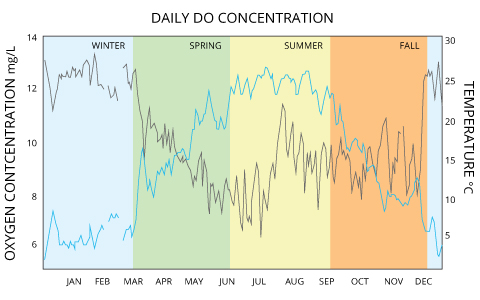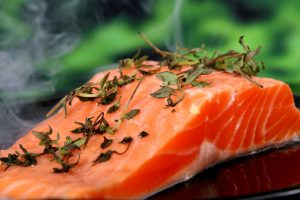Dissolved Oxygen: A Key Component to Ethical Aquaculture
Food production hasn’t always kept the interests of the animal in mind. After all, they’re headed for the dinner plate anyway.
But, there is a growing interest in sustainable and ethical food, from both consumers and governmental or non-profit organizations that hand out accreditation for sustainably and ethically raised food.
The aquaculture industry hasn’t skipped out on this development either. A quick scan of the frozen or fresh fish in a grocery store reveals at least a couple, if not more, seals, stamps or signs of approval from one organization or another.
While those ethical seafood accreditations aren’t all equal, when they lay out specific standards, they almost all have something to say about dissolved oxygen. Dissolved oxygen is so often included because it has major implications for animal welfare and the environmental impacts of fish farms.
Dissolved Oxygen and Environmental Impact
Most of the dissolved oxygen standards put forward by groups that provide sustainable aquaculture certification are concerned with aquaculture’s broader environmental impacts.
Nearly every set of standards has dissolved oxygen requirements for effluent, the water running out of ponds or raceways and into the local environment.
The Aquaculture Stewardship Council, one certifying organization, requires that effluent can’t have dissolved oxygen levels below 3 parts per million (ppm).
Water with 3 ppm of dissolved oxygen would likely be below naturally occurring levels. Releasing a lot of oxygen depleted water could depress oxygen levels in surrounding waters, harming local wildlife.
Other standards from the Aquaculture Stewardship Council look at the change in dissolved oxygen in the water surrounding the farm.
Dissolved oxygen has a natural diurnal cycle. It has a normal peak right before the sun goes down, after plants have spent all day producing oxygen. And, it reaches a natural low before the sun comes up, after photosynthesis has stopped and fish and plants continue to consume oxygen through respiration.

Daily dissolved oxygen concentrations (Image Credit: Fondriest Environmental)
Larger swings in dissolved oxygen levels between night and day could be an indication of eutrophication and high levels of plant life. More plants mean more oxygen produced in the sunlight and more consumed at night. They might also precede a hypoxic event, when dissolved oxygen levels fall to levels that can harm fish.
Although it can vary, standards for diurnal changes in dissolved oxygen most often allowed no more than a 65% change in dissolved oxygen for the surrounding waters.
The contribution of aquaculture effluent to big diurnal changes in dissolved oxygen doesn’t have to do with the effluent’s dissolved oxygen levels, but it’s nutrients.
Nutrients like phosphorus and nitrogen (in its various forms) can spur plant growth above normal levels.
Large hypoxic zones driven by agricultural runoff neatly illustrate the problem sustainable agricultural schemes are trying to avoid. High nutrients loads from intensive (fish) farming can cause harm to important freshwater and marine resources.
Many sustainable or ethical certifications require frequent and long-term monitoring of a farm’s effluent and the surrounding water to ensure the health of ecosystems, whether that’s freshwater lakes and ponds or marine waters below and around salmon pens.
Dissolved Oxygen and Animal Welfare
GLOBALG.A.P., a certification organization supported by various agricultural industries, lays out the general requirements for ethical fish farming like this: “The farm shall have in place a risk-based monitoring and control system for water quality to ensure the health and welfare of the fish is not compromised.”
In many ways, healthy and well fish are an aquaculture farmer’s goal anyway. Healthy fish grow well and, by definition, aren’t sick. We know that dissolved oxygen is one key requirement for fish health.
One leading certification organization, Best Aquaculture Practices, requires simply that “Adequate levels of dissolved oxygen shall be maintained.”
In salmon farming, where pens offshore are frequently employed, the Aquaculture Stewardship Council requires 70% or more oxygen saturation within the “allowable zone of effect,” which includes the pen and about 30 meters on all sides.

Ethical and sustainable seafood is in rising demand. Dissolved oxygen is often a requirement for ethical and sustainable certification. (Credit: Venus Fomby)
Organizations list some specific standards—reducing food when dissolved oxygen levels fall below 5mg/L—but most standards are general since dissolved oxygen requirements vary from species to species. If water is already kept at levels that allow for the greatest growth, then it probably meets the standard for fish welfare.
Whether it’s for animal welfare or nearby environmental health, any ethical and sustainable fish farm is going to have a particular need for frequent dissolved oxygen monitoring.
For example, the Aquaculture Stewardship Council requires weekly averages for many of its dissolved oxygen standards. However, that actually means twice-daily measurements, one in the morning, one in the evening.
These measurements ought to be done with a dissolved oxygen sensor or a more accurate chemical method, the Aquaculture Stewardship Council says.
However, all things being equal, choosing between a sensor that can be set and left to record DO levels on its own and taking manual measurements twice daily should be a no brainer.
There are dissolved oxygen meters for all needs and at a variety of price points. The first step in managing dissolved oxygen well (and sustainably and ethically) is actually to measure what it’s doing on your farm.
Top image: A salmon farm in Australia. (Credit: CSIRO)

0 comments